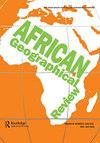Spatiotemporal climate variability and trends in UNESCO designated Cultural Landscapes of Konso, Ethiopia
IF 1.1
Q3 GEOGRAPHY
引用次数: 2
Abstract
ABSTRACT Understanding spatiotemporal patterns of climate variability and trends is essential to designing context-specific adaptation and mitigation interventions for climate change impacts. To this end, this paper examines the 1983–2016 rainfall and temperature variability and trends using merged satellite-gauge station data in the UNESCO designated Cultural Landscapes of Konso, Ethiopia. We have employed a non-parametric Mann-Kendall test to analyze rainfall and temperature trends, whereas the coefficient of variation (CV) has been used for variability analysis. The distribution and severity of meteorological droughts were mapped using the Standardized Precipitation Index (SPI). Our findings revealed an increase in annual and summer (Kiremt) season rainfall by 3.16 mm and 0.42 mm per year, respectively. However, rainfall in the spring (Belg) season decreased by 1.12 mm per year. Our findings also showed a substantial spatiotemporal variability in drought events due to variations in rainfall and topography. Consequently, the observed increase in frequency and the spatial extent of drought pose potential threats to rainfed farming, which gradually exposes smallholders to food insecurity and socioeconomic vulnerability. Therefore, agroecological-based local adaptation and mitigation interventions to climate variability are needed to enhance the resilience of smallholder farmers and ensure the continuity of the Konso cultural landscapes.联合国教科文组织指定的埃塞俄比亚孔索文化景观的时空气候变化和趋势
了解气候变率的时空格局和趋势对于设计针对气候变化影响的适应和减缓干预措施至关重要。为此,本文使用联合国教科文组织指定的埃塞俄比亚孔索文化景观的合并卫星测量站数据,研究了1983-2016年的降雨量和温度变化和趋势。我们采用非参数Mann-Kendall检验来分析降雨和温度趋势,而变异系数(CV)则用于变异性分析。利用标准化降水指数(SPI)绘制了气象干旱的分布和严重程度图。研究结果显示,年降雨量和夏季降雨量分别增加了3.16 mm和0.42 mm /年。然而,春季(比利时)的降雨量每年减少1.12毫米。我们的研究结果还表明,由于降雨和地形的变化,干旱事件具有实质性的时空变异性。因此,观测到的干旱频率和空间范围的增加对雨养农业构成了潜在威胁,这逐渐使小农面临粮食不安全和社会经济脆弱性。因此,需要以农业生态为基础的地方适应和缓解气候变化的干预措施,以增强小农的复原力,并确保孔索文化景观的连续性。
本文章由计算机程序翻译,如有差异,请以英文原文为准。
求助全文
约1分钟内获得全文
求助全文

 求助内容:
求助内容: 应助结果提醒方式:
应助结果提醒方式:


